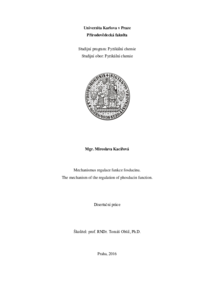Mechanismus regulace funkce fosducinu
The mechanism of the regulation of phosducin function
dissertation thesis (DEFENDED)

Reason for restricted acccess:
The annexes of the thesis or its part are inaccessible in accordance with article 18a (7) of The Code of Study and Examination in conjunction with Article 9 of the Rector’s Directive No. 6/2010.
View/
Permanent link
http://hdl.handle.net/20.500.11956/1146Identifiers
Study Information System: 117028
CU Caralogue: 990021170280106986
Collections
- Kvalifikační práce [20869]
Author
Advisor
Referee
Krůšek, Jan
Pavlíček, Jiří
Faculty / Institute
Faculty of Science
Discipline
Fyzikální chemie
Department
Department of Physical and Macromolecular Chemistry
Date of defense
13. 12. 2016
Publisher
Univerzita Karlova, Přírodovědecká fakultaLanguage
Czech
Grade
Pass
Keywords (Czech)
fosducin, 14-3-3, fluorescence, interakce, strukturaKeywords (English)
phosducin, 14-3-3, fluorescence, interaction, structurePředkládaná disertační práce volně navazuje na mou práci diplomovou. Zabývá se studiem 30kDa proteinu fosducinu (Pdc) a mechanismem regulace jeho funkce prostřednictvím vazby s 28kDa adaptorovým proteinem 14-3-3. Oba tyto proteiny se účastní signální dráhy spojené s G-proteiny, především v procesu vidění. Pdc váže komplex βγ podjednotek heterotrimerního G-proteinu transducinu (Gtβγ) a tím brání zpětné reasociaci Gtβγ s podjednotkou Gtα, čímž blokuje přenos světelného signálu. Tento proces se pravděpodobně uplatňuje při dlouhodobé adaptaci na změnu intenzity světla. Regulační funkce Pdc je dále regulována jeho fosforylací a následnou vazbou na protein 14-3-3. Na základě dostupných dat bylo spekulováno, že vazba 14-3-3 je klíčová pro inhibici interakce mezi fosforylovaným Pdc (Pdc-PP) a Gtβγ. Vznik komplexu 14-3-3/Pdc-PP pak vede k reasociaci trimerního transducinu a zesílení přenosu světelného signálu. Mechanismus, jakým protein 14-3-3 inhibuje interakci Pdc s Gtβγ, je však stále neznámý. Cílem této disertační práce bylo objasnit strukturu volného Pdc a jeho komplexu s proteinem 14-3-3 a s pomocí získaných dat navrhnout mechanismus regulace funkce Pdc. Struktura Pdc a komplexu 14-3-3/Pdc-PP byla studována celou řadou biofyzikálních metod včetně maloúhlového rozptylu rentgenového záření (SAXS), NMR,...
This dissertation is focused on 30 kDa protein phosducin (Pdc) and on the regulation of its function through the interaction with 28 kDa adaptor protein 14-3-3. These two proteins participate in G-protein signal transduction pathways, especially in the process of light signal transduction. It is assumed that Pdc binds to the Gtβγ complex of G-protein called transducin and through this interaction it inhibits the reassociation of Gtβγ with Gtα thus reducing the visual signal transfer. This process is thought to participate in a long- term light adaptation. The regulation of Pdc function is further regulated by its phosphorylation and subsequent binding to the 14-3-3 protein. It has been speculated that the 14-3-3 binding plays a key role in the inhibition of the interaction between phosphorylated Pdc (Pdc-PP) and Gtβγ. The formation of the 14-3-3/Pdc-PP complex leads to the reassociation of Gtβγ with Gtα and consequently to the amplification of visual signal transfer. Nevertheless, the mechanism by which the 14-3-3 protein binding inhibits the interaction between Pdc and Gtβγ remains elusive. The main aims of this dissertation were: (i) to investigate the structure of Pdc in its apo-state (in the absence of the binding partner) and in the complex with 14-3-3, and (ii) to suggest the mechanism of the...
